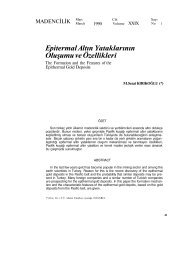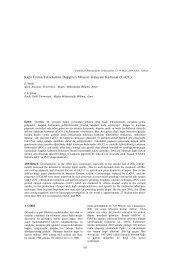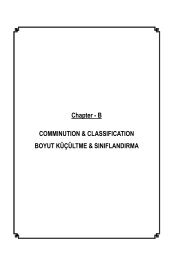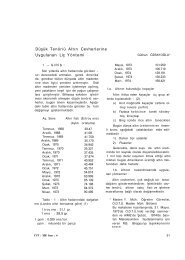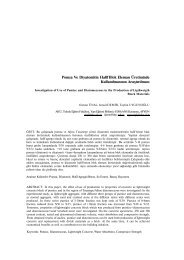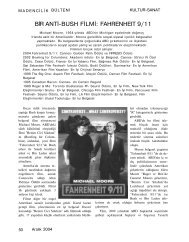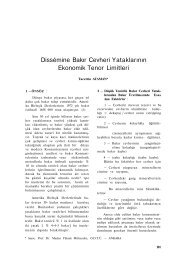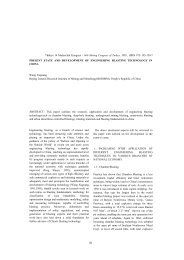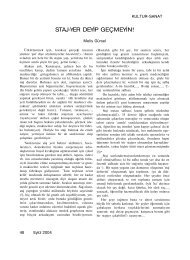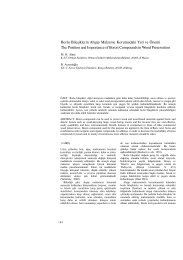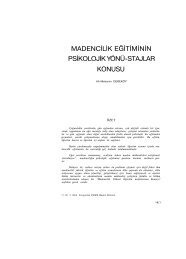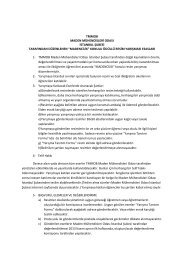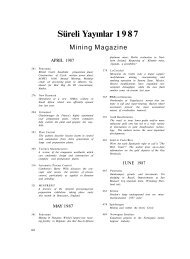A OPEN PIT MINING AÇIK OCAK MADENCİLİĞİ
A OPEN PIT MINING AÇIK OCAK MADENCİLİĞİ
A OPEN PIT MINING AÇIK OCAK MADENCİLİĞİ
Create successful ePaper yourself
Turn your PDF publications into a flip-book with our unique Google optimized e-Paper software.
23 rd <br />
largely covered by Quaternary rocks, as<br />
shown in Figure 1 (Moritz et al., 2006).<br />
The Muteh complex consists of 9 gold<br />
deposits for gold mineralization that Chah<br />
Khaton and Senjedeh are extracted since<br />
1991, as depicted in Figure 2 (Moritz et al.,<br />
2006). The rocks in the vicinity of the Muteh<br />
deposit are predominantly schist and gneiss,<br />
subsidiary amphibolite and quartzite, and<br />
local marble and magnetite horizons (Thiele<br />
et al., 1968; Paidar-Saravi, 1989).<br />
Figure 2. Location of the Muteh complex and<br />
the Iranian famous hydrothermal deposits at<br />
the intersection of the Sanandaj–Sirjan<br />
metamorphic zone with magmatic belt of<br />
Urumieh–Dokhtar. Simplified tectonic map<br />
of southwestern Iran, showing the<br />
subdivisions of the Sanandaj-Sirjan tectonic<br />
zone (Stöcklin, 1968 and Daliran, 2008)<br />
The schist contains mainly quartz, biotite,<br />
chlorite, and muscovite. The granitic rocks<br />
emplaced in the metamorphic complex in the<br />
immediate vicinity of the Muteh gold mine<br />
are mediumgrained biotite and two-mica<br />
leucogranites, which locally can be<br />
extremely rich in quartz and feldspar and<br />
mica poor (Thiele et al., 1968). Hornfelsic<br />
rocks result from contact with the granite<br />
(Paidar-Saravi, 1989).<br />
Paidar-Saravi (1989) also described a<br />
range of different meta-volcanic rocks,<br />
including rhyolitic, dacitic, and andesitic tuff<br />
and lava, which were already described in<br />
internal reports of the Geological Survey of<br />
Iran (Alavi- Tehrani, 1980, cited in Paidar-<br />
Saravi, 1989). According to Paidar-Saravi<br />
(1989), these rocks have a granolepidoblastic<br />
texture with quartz and feldspar<br />
forming a mosaic intergrowth and mica and<br />
chlorite defining the foliation. Pyrite and<br />
locally larger crystals of are also mentioned.<br />
Paidar-Saravi (1989) described the metavolcanic<br />
rocks as interlayered with schist but<br />
provided no further textural evidence that<br />
they are tuffs or lavas. During our fieldwork,<br />
we did not recognize any primary textures,<br />
and these rocks cannot be distinguished from<br />
the other metamorphic rocks in the area.<br />
Therefore, we refer to them as gneiss or<br />
schist. Rachidnejad-Omran et al. (2002) also<br />
mentioned the presence of meta-rhyolite and<br />
meta-volcanic tuff, in spatial association with<br />
higher gold grades, but with no additional<br />
evidence for this rock classification. They<br />
interpreted the meta-rhyolite together with<br />
the amphibolite as a bimodal volcanic suite<br />
and the host schist and gneiss as an early<br />
Paleozoic (to Late Proterozoic) volcanosedimentary<br />
complex.<br />
Hydrothermal alteration associated with<br />
the gold occurrences is characterized by<br />
intense, pervasive bleaching of the host<br />
rocks. In areas where alteration is less<br />
intense, it can be seen that the bleaching<br />
occurs along small fractures crosscutting the<br />
sub-horizontal foliation of the host rocks<br />
(Moritz et al., 2006). It consists of silicified<br />
rock with microcrystalline to crystalline<br />
quartz, fine-grained muscovite, pyrite,<br />
dolomite-ankerite, and albite overprinting the<br />
metamorphic minerals of the host rocks.<br />
Lithological units in Dareh-Ashki deposit<br />
concluded green schist, granite and<br />
hornfelse. Some parts of the deposit covered<br />
179



